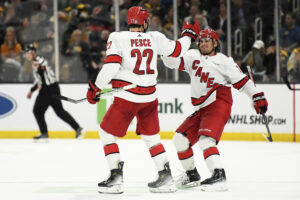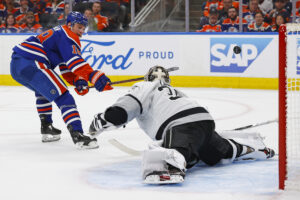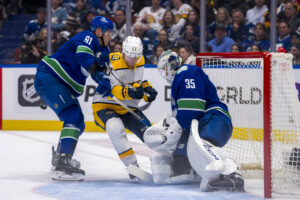Last Word on Hockey is bringing you its Black Aces Series, covering every team in the upcoming Stanley Cup Playoffs. Recently the NHL owners and NHLPA agreed to an expanded playoff format to finish the 2019-2020 season and award the Stanley Cup. There will be 24 teams participating as opposed to the normal 16 teams. Today, we feature the Columbus Blue Jackets Black Aces.
There are a lot of details to be worked out as well as the schedule and location of the games. With the AHL season being cancelled, that makes a lot more players available to the NHL teams participating. NHL Black Aces are once again in the news so today we are looking at which players may be among the Columbus Blue Jackets Black Aces selected.
Columbus Blue Jackets Black Aces
The term “Black Ace” was once used negatively. The term originated from Eddie Shore, who would refer to spare players as a “Black Ace.” Shore would say that a team would be in bad shape if they had to use one of their Black Aces in a game. However, recently, it has been used more positively. A team would use a Black Ace to help them overcome the loss of a player or if they thought a different player could be utilized in a way to help the team win. Let’s look at the Blue Jackets aces in the hole.
There is a chance, especially at forward, that we could see Black Aces play. Columbus only has one full-time player, Devin Shore, scratched for Liam Foudy in beat reporter Aaron Portzline’s estimation of their playoff line-up. We’re not considering full-time players as Black Aces in this series, so Shore doesn’t count. However, given that Foudy has not proven himself as a full-time NHLer yet, he’s going to be a Black Ace and Shore will get that spot for this article. That leaves defencemen Scott Harrington and Dean Kukan as the only full-time NHL players scratched. The Blue Jackets lost 419 man-games to injury this season, if the injury bug follows them, there could be many Black Aces that play. Let’s see whom they are starting with the forwards.
Liam Foudy
In this year’s Future Watch edition of the Hockey News, Portzline wrote that Foudy “would almost certainly” have made the team this year if he didn’t have a shoulder injury in the preseason. Foudy played most of this season in the Ontario Hockey League, scoring 68 points in 45 games and scored four points in seven games on Canada’s world junior gold medal team. However, he played two games in the NHL because of a rarely used rule between the NHL and Canadian Hockey League, and was effective. He scored an assist, never gave the puck up, had three shots and hits, and had a 65 corsi for percentage during even strength.
Foudy’s best asset is his skating. He is lightning fast. His speed allows him to be an effective forechecker and a dangerous penalty killer. However, writers like Portzline and Scott Wheeler and Corey Pronman of the Athletic have questioned whether Foudy has enough offensive skill to go along with his speed. Time will tell, but a safe bet for right now is he will be a Carl Hagelin type of player. Tough to play against because of his speed, but a secondary threat offensively.
Foudy is listed as a Black Ace because he isn’t a full-time NHL player. However, he could force his way into being a full-time player for the Blue Jackets in the playoffs.
Nathan Gerbe
Nathan Gerbe has played in 426 NHL games, but it looked like his days as a regular NHL player were done. He left the NHL for Switzerland early in the 2016-17 season and only played in two NHL games since then entering into this season. Injuries allowed Gerbe back into the NHL this year, and in 30 games, he scored 10 points. Gerbe is quick and has excellent stick skills, which enables him to be a factor offensively. He’s also got a mean streak even though he’s 5’4. If he played a full 82 game season, Gerbe would have been on pace for 123 hits, which would have been third on the team. He went viral this year after taking down 6’3 Travis Sanheim in a fight after delivering a big hit to Claude Giroux. The video is below. His offence, work ethic and feistiness make him a fan favourite.
Gerbe struggled defensively, his 46.07 corsi for percentage during even strength was the worst of his career. He has an expected goals against of 13.1 but gave up 22 according to Natural Stat Trick. That probably won’t work against him too much. If Columbus is mentally feeling down or tired in a series, he can inject some life with a goal or a big hit. Portzline calls him Columbus’s “No.1 Firestarter.”
Kevin Stenlund
Coming into the season, Kevin Stenlund was ranked as Columbus’s 12 best prospect by Cory Pronman. He jumped up considerably this year, and played 32 games in the NHL, scoring 10 points. He’s a big forward at 6’4 and 209 pounds and can play either centre or right-wing. Stenlund’s best asset is his puck skills. He has soft hands, good passing ability and a fantastic shot. Stenlund has a quick release, and his shots are hard and accurate. Just check out the video below. He’s also extremely reliable with the puck. He only committed five turnovers this year, which is lowest on the team for players who have played over 30 games. His most significant issue is that he is not a great skater.
If the Blue Jackets have injury trouble on the right-wing, that is where Stenlund will get into action. His shot and puck protection should make him a useful player.
Andrew Peeke
The 21-year-old defencemen, Andrew Peeke, had a good rookie season. He scored 16 points in 29 games in the AHL for the Cleveland Monsters. In the NHL, he didn’t often score with three points in 22 games, but he was effective defensively. Among defencemen that played over 100 minutes for the Blue Jackets this season, Peeke led them in even-strength corsi for percentage (52.3), shots for percentage (54.14) and scoring and high danger chance percentage (53.47 and 57.32). All those stats are from Natural Stat Trick. He could knock off Markus Nutivaara for the final spot on the defence once the pay-in starts. But Nutivaara is more experienced, so he has the edge right now.
In his examination of the Blue Jackets prospect pool, Scott Wheeler wrote that Peeke plays a steady game, he doesn’t show much flash, but he’s a good puck mover and wins his puck battles.
Gabriel Carlsson
After Peeke, it is a toss-up whether Gabriel Carlsson or Adam Clendening get the next call. Carlsson shoots left and Clendening shoots right, so it will probably come down to what type of shot they need. It also may come down to circumstances. Carlsson is a 23-year-old former first-round pick. If Columbus is early in a series, it is more likely they call on Carlsson to see what he can do. If it is a tighter series, they will call on Clendening, who played seven games for Columbus in last year’s playoffs, so he has more experience.
In the same article where he talked about Peeke, Wheeler says Carlsson is a smooth-skating defensemen who can move the puck up the ice. However, he doesn’t have the offensive tools to be an offensive threat. Carlsson’s more of a stable presence on the blueline. He’s 6’5 but only 192 pounds, which is not a lot for his height. Portzline writes in Future Watch that Carlsson is knocked off the puck too easily.
Adam Clendening
It is not too hard to imagine what Adam Clendening would look like if called into action as one of the Columbus Blue Jackets Black Aces because he did it last year. Nutivaara was hurt and couldn’t play in the last game of their first-round series against the Tampa Bay Lightning. Clendening stepped in and played for the remainder of Columbus’s playoff run. In seven games, he tallied nine shots, three blocked shots and six hits. Clendening didn’t have a huge role, playing under ten minutes per game. But he was steady. That is the role he would have if he sees action this year.
Matiss Kivlenieks
Surprisingly, Matiss Kivlenieks is the second Latvian goaltender the Blue Jackets have. Elvis Merzlikins is the other. He had an okay season. In the AHL, he posted a .904 save percentage and 2.96 goals-against average. He was similar in the NHL, posting a .898 save percentage and 2.95 goals-against average. Now goalies can randomly be crazy good at any moment. But chances are if Kivlenieks sees action, he’ll hover around a .900 save percentage and be giving up around two to three goals a game.






